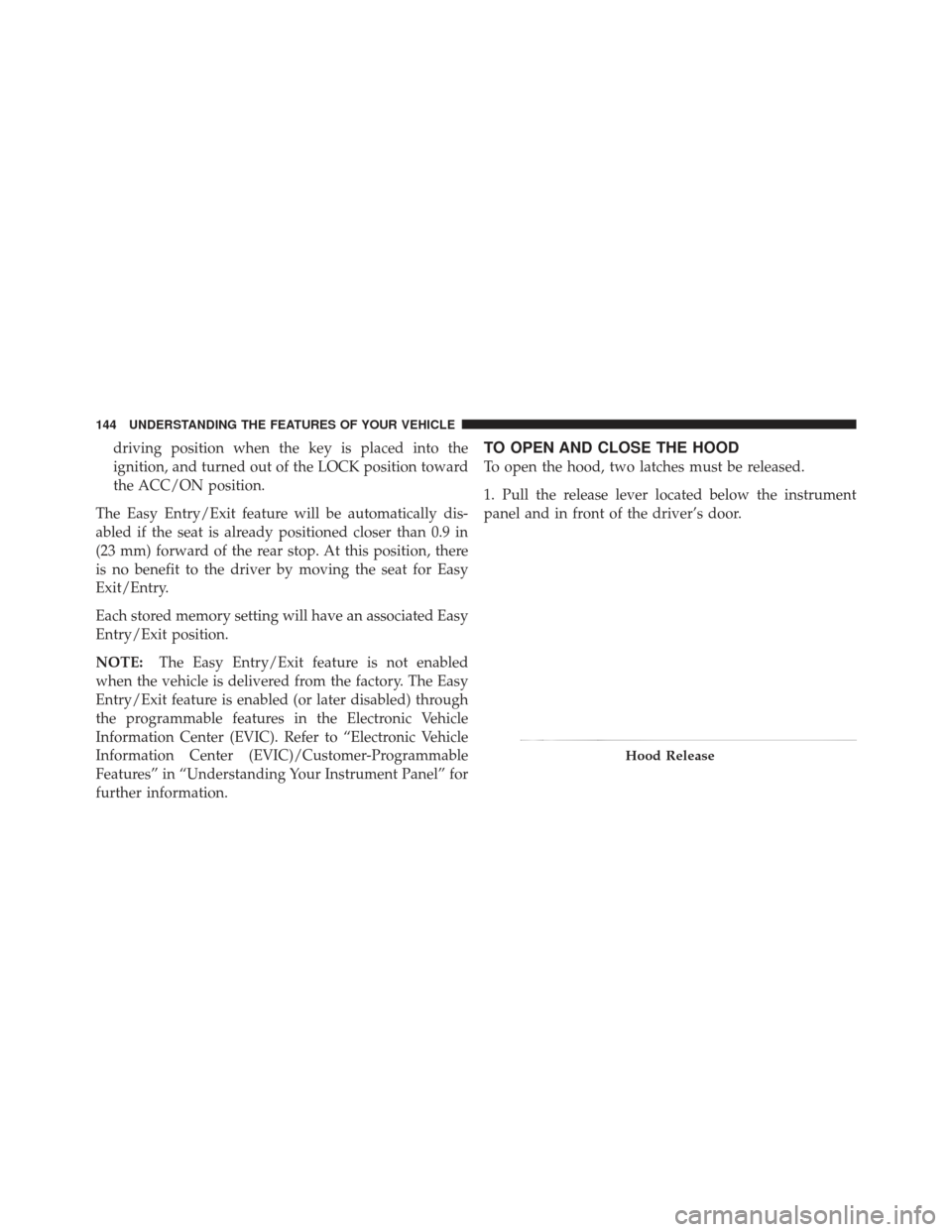Page 32 of 587

WARNING!
•Do not start or run an engine in a closed garage or
confined area. Exhaust gas contains Carbon Mon-
oxide (CO) which is odorless and colorless. Car-
bon Monoxide is poisonous and can cause serious
injury or death when inhaled.
•Keep Remote Keyless Entry (RKE) transmitters
away from children. Operation of the Remote Start
System, windows, door locks or other controls
could cause serious injury or death.
Remote Start Abort Message On Electronic Vehicle
Information Center (EVIC) — If Equipped
The following messages will display in the EVIC if the
vehicle fails to remote start or exits remote start prema-
turely:
•Remote Start Aborted — Door Ajar
•Remote Start Aborted — Hood Ajar
•Remote Start Aborted — Fuel Low
•Remote Start Aborted — System Fault
•Remote Start Disabled — Start Vehicle to Reset
The EVIC message stays active until the ignition is turned
to the ON/RUN position.
To Enter Remote Start Mode
Press and release the REMOTE START button
on the RKE transmitter twice, within five sec-
onds. The vehicle doors will lock, the parking
lights will flash and the horn will chirp twice (if
programmed). Then, the engine will start and the vehicle
will remain in the Remote Start mode for a 15 minute
cycle.
30 THINGS TO KNOW BEFORE STARTING YOUR VEHICLE
Page 146 of 587

driving position when the key is placed into the
ignition, and turned out of the LOCK position toward
the ACC/ON position.
The Easy Entry/Exit feature will be automatically dis-
abled if the seat is already positioned closer than 0.9 in
(23 mm) forward of the rear stop. At this position, there
is no benefit to the driver by moving the seat for Easy
Exit/Entry.
Each stored memory setting will have an associated Easy
Entry/Exit position.
NOTE: The Easy Entry/Exit feature is not enabled
when the vehicle is delivered from the factory. The Easy
Entry/Exit feature is enabled (or later disabled) through
the programmable features in the Electronic Vehicle
Information Center (EVIC). Refer to “Electronic Vehicle
Information Center (EVIC)/Customer-Programmable
Features” in “Understanding Your Instrument Panel” for
further information.TO OPEN AND CLOSE THE HOOD
To open the hood, two latches must be released.
1. Pull the release lever located below the instrument
panel and in front of the driver’s door.
Hood Release
144 UNDERSTANDING THE FEATURES OF YOUR VEHICLE
Page 248 of 587
INSTRUMENT PANEL FEATURES
1 — Air Outlet6 — Lower Switch Bank11 — Hood Release
2 — Instrument Cluster 7 — Hazard Switch12 — Fuel Door Release
3 — Radio 8 — Storage Bin13 — Headlight Switch
4 — Glove Compartment 9 — ESC Button14 – Dimmer Control
5 — Climate Controls 10 — Ignition Switch
246 UNDERSTANDING YOUR INSTRUMENT PANEL
Page 498 of 587

Refrigerant Recovery and Recycling
R-134a Air Conditioning Refrigerant is a hydrofluoro-
carbon (HFC) that is endorsed by the Environmental
Protection Agency (EPA) and is an ozone-saving product.
However, the manufacturer recommends that air condi-
tioning service be performed by authorized dealers or
other service facilities using recovery and recycling
equipment.
Body Lubrication
Locks and all body pivot points, including such items as
seat tracks, door hinge pivot points and rollers, liftgate,
tailgate, sliding doors and hood hinges, should be lubri-
cated periodically with a lithium based grease, such as
MOPAR�Spray White Lube or equivalent to assure
quiet, easy operation and to protect against rust and
wear. Prior to the application of any lubricant, the parts
concerned should be wiped clean to remove dust and
grit; after lubricating excess oil and grease should be
removed. Particular attention should also be given to hood latching components to ensure proper function.
When performing other underhood services, the hood
latch, release mechanism and safety catch should be
cleaned and lubricated.
The external lock cylinders should be lubricated twice a
year, preferably in the Fall and Spring. Apply a small
amount of a high quality lubricant, such as MOPAR�
Lock Cylinder Lubricant or equivalent directly into the
lock cylinder.Windshield Wiper Blades
Clean the rubber edges of the wiper blades and the
windshield periodically with a sponge or soft cloth and a
mild nonabrasive cleaner to remove accumulations of salt
or road film.
Operation of the wipers on dry glass for long periods
may cause deterioration of the wiper blades. Always use
washer fluid when using the wipers to remove salt or dirt
from a dry windshield.
496 MAINTAINING YOUR VEHICLE
Page 573 of 587

GaugesCoolant Temperature ................... 257
Fuel ............................... 256
Speedometer ......................... 255
Tachometer .......................... 248
Gear Ranges ........................... 350
Gear Select Lever Override ................. 476
General Information ...............20,28,188,424
Glass Cleaning .......................... 519
Gross Axle Weight Rating ...............437,439
Gross Vehicle Weight Rating .............436,439
GVWR ............................... 436
Hands-Free Phone (uconnect™) .............. 121
Hazard Warning Flasher ................... 462
Headlights ............................ 527
Bulb Replacement ...................... 527
Cleaning ............................ 518
On With Wipers ....................... 147 Replacing
........................... 527
Heated Mirrors ......................... 111
Heater ............................... 324
Heater, Engine Block ..................... 348
High Beam Indicator ..................... 250
Hill Descent Control ..................... 390
Hill Descent Control Indicator ............... 250
Hill Start Assist ......................... 387
Hitches Trailer Towing ........................ 443
Holder, Cup ........................... 228
HomeLink® (Garage Door Opener) Transmitter . . 208
Hood Release .......................... 144
Ignition ............................... 16
Key ............................... 14,16
Ignition Key Removal ..................... 16
Illuminated Entry ........................ 23
Immobilizer (Sentry Key) ................... 19
10
INDEX 571